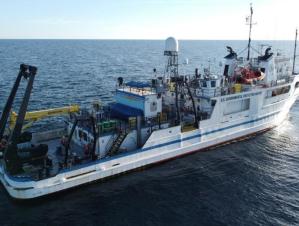

written by Susan Daniel, Lyubov Burlakova, and Alexander Karatayev
Researchers were finally able to return to sampling all five Great Lakes as a part of the Great Lakes National Program Office (GLNPO) Biology Monitoring Program after a year-long hiatus in 2020 due to the COVID pandemic. Operations were anticipated to be “business as usual” with a few additional health and safety protocols including the requirement of a COVID-19 vaccination and a ship-wide negative PCR result. The ship was set to sail out of Milwaukee, Wisconsin on August 2nd, but the cruise was delayed due to unforeseen engine trouble shortly before leaving dock. The extent of engine trouble was revealed and subsequent delays grew until finally alternative plans needed to be made. Luckily, there are other research vessels throughout the Great Lakes. Samples from Lakes Erie and Ontario were graciously collected and coordinated by collaborators at GLNPO, Great Lakes Laboratory for Fisheries and Aquatic Sciences (Fisheries and Oceans Canada), Great Lakes Science Center (USGS), Cornell University, and our very own Mark Clapsadl and Brian Haas.
The survey of the remaining lakes was finally resumed in early September in lieu of the scheduled Cooperative Science and Monitoring Initiative (CSMI) Lake Superior survey, which was postponed until the 2022 field season. Lyuba Burlakova, Alexander Karatayev, and Vadim Karatayev (GLC Adjunct research scientist) represented the GLC on the survey of Lakes Michigan, Huron, and Superior.
While on this survey, they used the Benthic Imaging System (BIS) to finish the rapid assessment of Dreissena in Lake Michigan, counting dreissenids in pictures cut from video files. Additionally, they were able to beta-test a new method of observing Mysis shrimp, native to the Great Lakes and an important food source for fisheries. The Lake Guardian was battered with bad weather and waves during this whole survey, but remarkably the crew pushed through these hardships and were able to collect samples from all the historic stations, providing crucial data after the gap created by COVID-19. Vadim used his small drone to record the Lake Guardian under way and during sampling, providing unique shots of the ship from above.
These surveys and subsequent data are used by managers and scientist throughout the Great Lakes basin to guide legislation, best management practices, and innovative research. We are indebted to the community of researchers who banded together and aided in gathering these invaluable samples during these trying times. We hope that the Biology Monitoring Program will be returned to normal and visit all five Great Lakes during the month of August in 2022.
Image caption: The R/V Lake Guardian collecting samples, as viewed from an aerial drone. (Photo credit: Vadim Karatayev)
Some content on this page is saved in PDF format. To view these files, download Adobe Acrobat Reader free. If you are having trouble reading a document, request an accessible copy of the PDF or Word Document.
